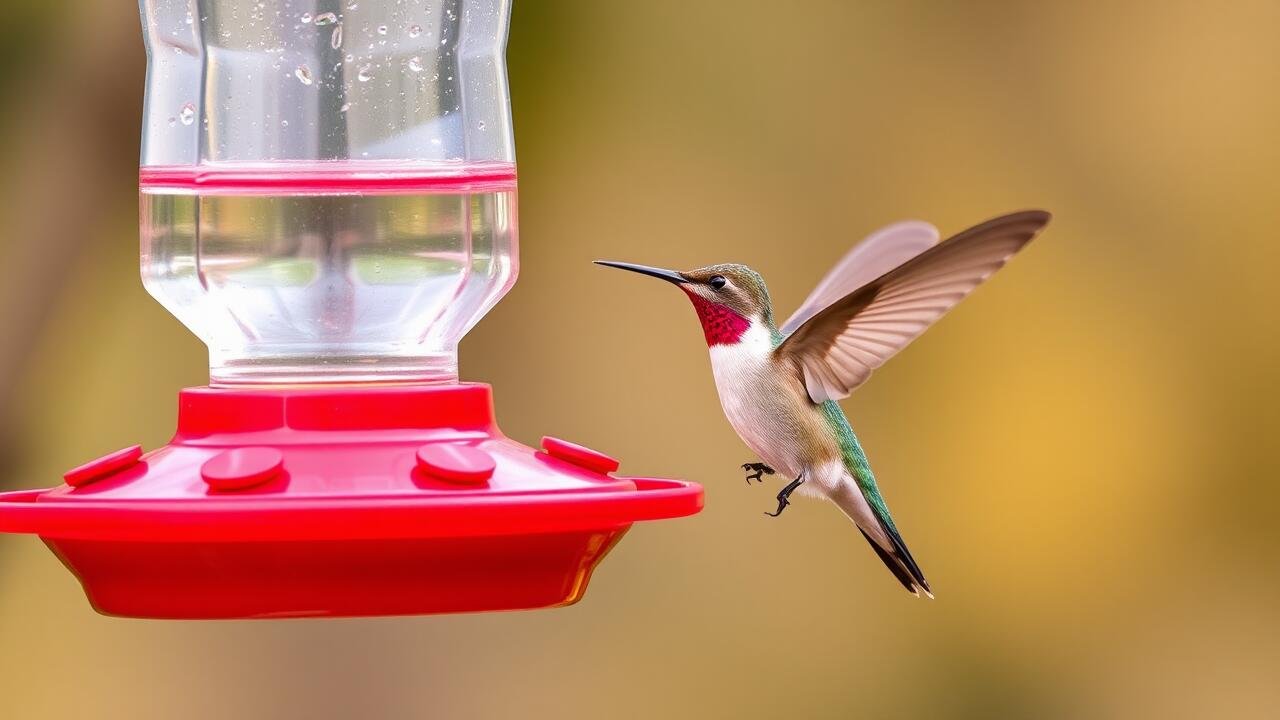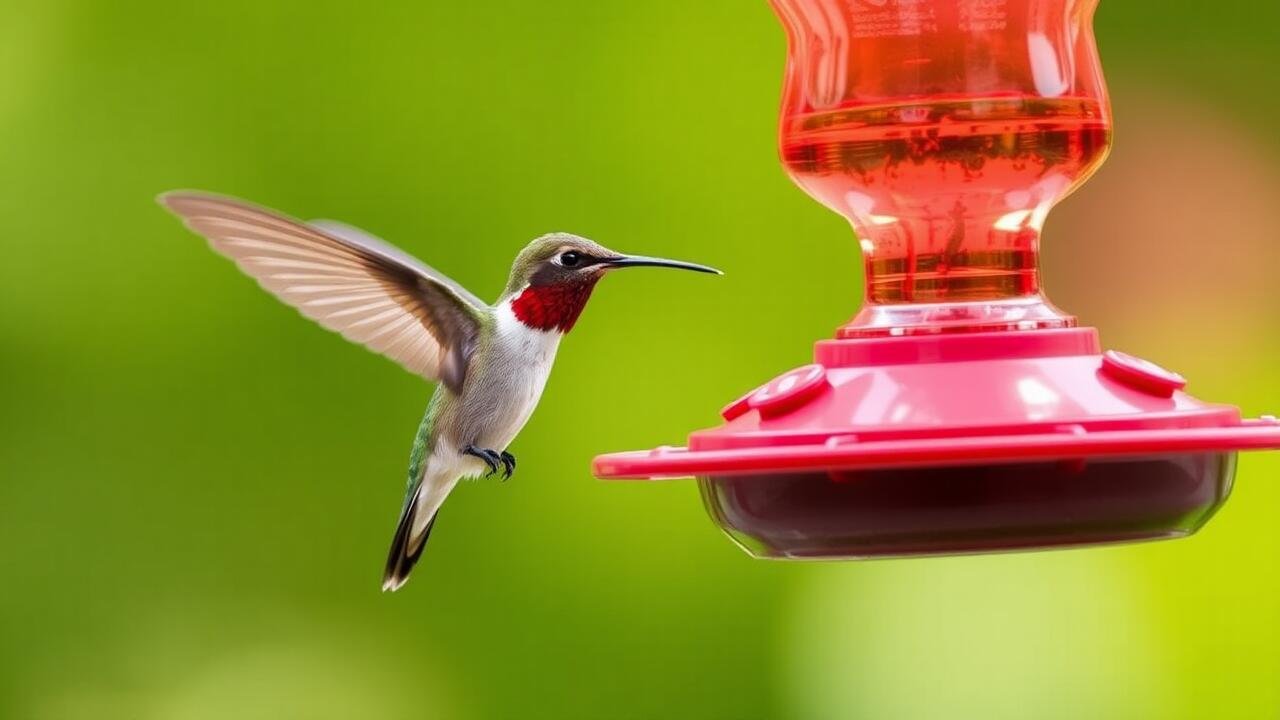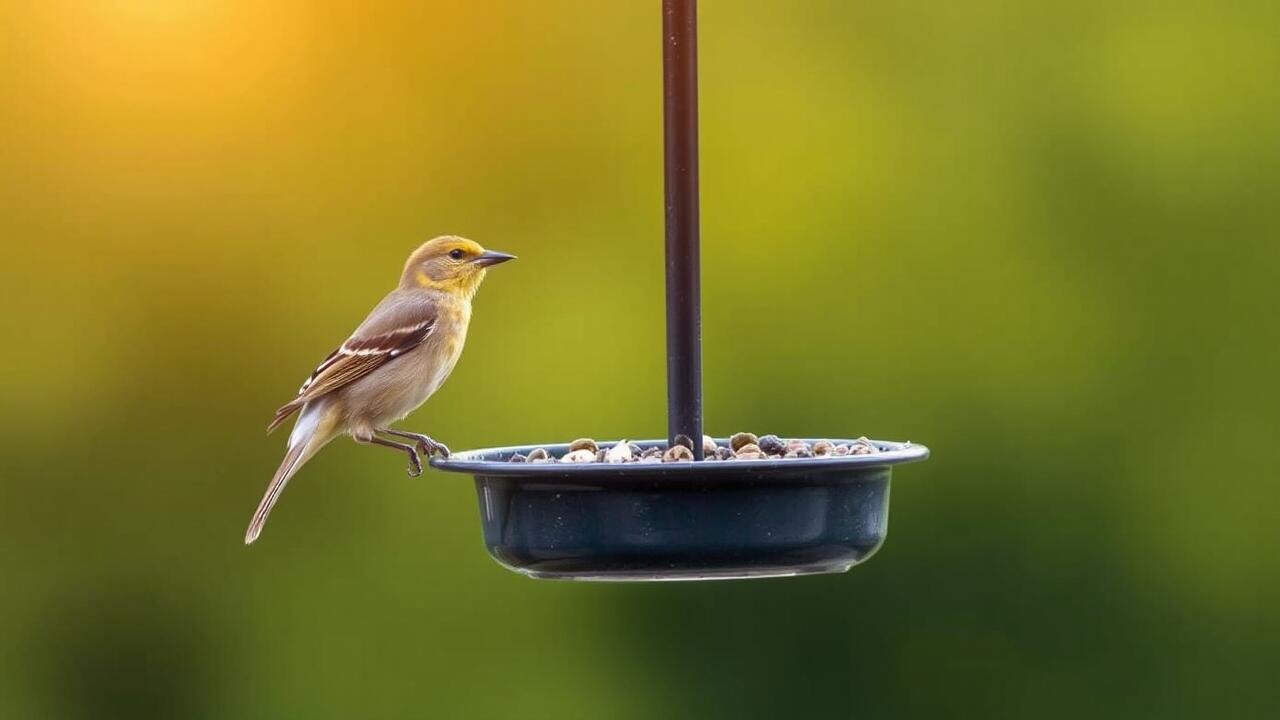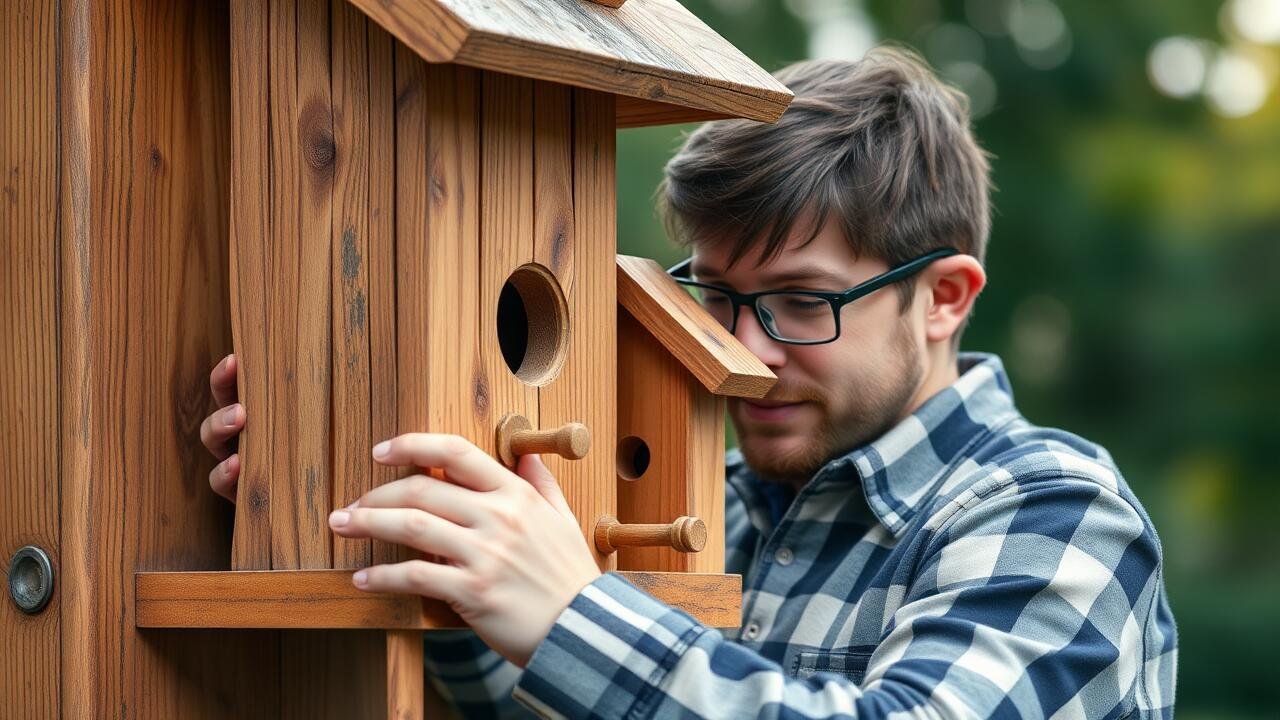Table Of Contents
The Ultimate Guide on How to Clean a Hummingbird Feeder and Maintain Your Hummingbird Feeders
Key Takeaways
- Significance of Maintaining a Hummingbird Feeder in Good Condition
- Materials Required for Cleaning a Hummingbird Feeder
- Detailed Instructions on How to Sanitize a Hummingbird Feeder
- Regularity of Cleaning Hummingbird Feeders
- Typical Errors to Avoid When Sanitizing Hummingbird Feeders
Importance of Keeping a Hummingbird Feeder Clean
A clean hummingbird feeder is crucial for attracting and nourishing hummingbirds, such as Anna’s hummingbirds, Costa’s hummingbirds, and Allen’s hummingbirds. Unclean feeders can lead to the growth of harmful mold and bacteria, which can severely affect the health of these delicate birds. Knowing how to clean a hummingbird feeder properly helps ensure that the nectar remains fresh and safe, promoting a steady visit from these vibrant birds. Regular maintenance also enhances the aesthetic appeal of your garden, making it a welcoming space not only for hummingbirds but also for other wildlife, such as those visiting a bird bath. Understanding the importance of cleanliness in hummingbird feeders is essential for bird enthusiasts aiming to create a thriving environment.

Benefits of a Clean Hummingbird Feeder
A clean hummingbird feeder serves as a reliable nectar source for these vibrant birds, attracting them more effectively. Birders know that regular cleaning ensures that the nectar remains fresh and free from contaminants, which is essential for the health of the birds. Knowing how to clean a hummingbird feeder involves using simple household items, like dishwashing soap, to eliminate residue. For a thorough cleaning, some feeders can even be placed in the dishwasher, making maintenance easier for busy birders.
Keeping the feeder clean also prevents the spread of diseases among birds. Mold or spoiled nectar can deter birds from visiting and may lead to health issues. Regularly checking and cleaning the feeder, especially before refilling it with nectar, is key. Storing any excess nectar in the refrigerator can help maintain its freshness and reduce waste. Ensuring the feeder is clean not only benefits the birds but also enhances the joy of birdwatching for enthusiasts.
Preventing Mold and Bacteria Growth
Regularly cleaning a hummingbird feeder is essential for preventing mold and bacteria growth. One effective method involves using a bucket filled with warm water and a few drops of dish soap. A soft sponge or brush can help remove any debris. A pipe cleaner is beneficial for reaching tight spots, ensuring that every nook and cranny is thoroughly cleaned. This practice keeps the feeder hygienic and reduces the risk of attracting harmful insects to your yard.
Taking proactive steps in maintaining your feeder can significantly extend its lifespan. Understanding how to clean a hummingbird feeder properly can also help keep your feathered friends healthy. For optimal results, wash the feeder every time you refill it. Regular use of dishwashing liquid ensures that harmful microorganisms do not establish a foothold. Keeping an eye on the condition of your feeder will make a difference in creating a safe feeding environment for hummingbirds.
Supplies Needed for Cleaning a Hummingbird Feeder
Keeping your hummingbird feeders in pristine condition is essential for maintaining the health and happiness of your feathered visitors. Knowing how to clean a hummingbird feeder efficiently is crucial for ensuring that the food is safe for the hummers. The right supplies can make the process straightforward and effective. Using a gentle cleaning solution, like a vinegar-water mix, is an excellent choice, ensuring you avoid harsh chemicals that could harm the birds. Essential tools such as bottle brushes and sponges can help reach every nook and cranny of your feeder, especially when tackling popular brands like Perky-Pet® hummingbird feeders. By having these supplies ready, you can easily clean feeder components, maintain the freshness of your hummingbird food solution, and meet the hummingbird food needs of your local hummers.
Recommended Cleaning Solutions
Using a mixture of vinegar and water is an effective solution for cleaning hummingbird feeders. This homemade solution not only disinfects but also helps to dissolve any residue from unconsumed hummingbird food. Many bird enthusiasts recommend a 1:4 ratio of vinegar to water to ensure a thorough cleansing without compromising the health of the birds. Knowing how to clean a hummingbird feeder with natural ingredients helps in maintaining a safe environment for these delicate creatures.
Bleach is another option, though it should be used sparingly and thoroughly rinsed away after cleaning. A small amount of bleach mixed with water can eliminate mold and bacteria that may develop in a nectar feeder. However, caution is advised, as leftover bleach can harm hummingbirds. Understanding how to clean a hummingbird feeder properly ensures that the hummingbird nectar remains safe and nutritious, fostering a thriving feeding station.
Essential Tools for Maintenance
To effectively maintain a clean hummingbird feeder, having the right tools is crucial. A bottle brush is particularly useful for cleaning the inside of glass bottle hummingbird feeders, ensuring that even hard-to-reach areas are free from residue. Having a soft sponge or a cloth allows for gentle cleaning of the feeder’s exterior, especially when dealing with a red feeder that may attract more dirt. Knowing how to clean a hummingbird feeder properly requires these essential tools to keep your feeder in top shape for feeding hummingbirds.
Another important tool is a small, rigid scrub brush. This tool works well for removing stubborn stains and buildup, which can detract from a hummingbird-friendly yard. A pair of gloves helps protect your hands while handling cleaning solutions, making the process more hygienic. It’s important to regularly check your feeders and use the appropriate maintenance tools to ensure they remain inviting for hummingbirds. Knowing how to clean a hummingbird feeder with the right supplies enhances the overall experience for these delicate birds.
- Regularly inspect your feeders for any signs of wear or damage.
- Use a mixture of vinegar and water for a natural cleaning solution.
- Rinse all components thoroughly to avoid any soap residue.
- Have a dedicated cleaning station for your tools to keep everything organized.
- Replace old or heavily stained feeders to ensure a safe feeding environment.
- Store cleaned feeders in a dry place to prevent mold growth.
- Keep a maintenance schedule to remind yourself when to clean and refill feeders.
Step-by-Step Guide on How to Clean a Hummingbird Feeder
Cleaning a hummingbird feeder is essential for maintaining a safe and inviting environment for these beautiful birds. To understand how to clean a hummingbird feeder effectively, start by disassembling the feeder parts. This allows you to reach all nooks and crannies where mold and bacteria might thrive. Using mild soap or a solution specifically designed for Perky-Pet® feeder cleaning ensures that you avoid leaving harmful residues, especially important because dirty feeders can deter hummingbirds. Regular maintenance is crucial, particularly for those who invest in expensive hummingbird nectar—keeping several feeders clean can also help in attracting more birds. Pay special attention to sugar-water feeders, which can quickly become moldy if not tended to frequently. Hummingbird lovers should be vigilant about the signs of dirty feeders and proactively implement a cleaning routine.

Preparing the Feeder for Cleaning
Cleaning a hummingbird feeder is crucial for ensuring the health and safety of local hummingbirds. Start by emptying any remaining sugar-water solution from the feeder. Dispose of any old nectar and rinse the feeder to remove residual sugar. Understanding how to clean a hummingbird feeder is essential for proper general feeder maintenance. This process not only supports hummingbirds year round but also enhances the feeder benefits, attracting more birds to your garden.
Before diving into the cleaning process, check for any nesting debris or residues from seed feeders that may have accumulated. This can interfere with the feeder’s function. Preparing the feeder properly helps maintain a clean environment for your sugar-water feeders. Effective cleaning practices will prevent the growth of mold or bacteria that could harm your visiting hummingbirds. Following best practices for cleaning ensures your feeder remains inviting for these beautiful creatures.
Effective Cleaning Techniques
Understanding how to clean a hummingbird feeder is crucial for maintaining a healthy feeding environment for these beautiful birds. Focus on cleaning both the feeder’s exterior and interior, especially hard-to-reach areas like the reservoirs. A mixture of hot water and a mild soap is often effective. For the nectar recipe, ensure that no bird feces or leftover nectar residue remains, as these can attract harmful bacteria. Many backyard birders share tips about using a brush specifically designed for feeder cleaning to help dislodge any stubborn debris.
To maintain the feeder’s integrity, avoid using harsh chemicals that could leave harmful residues. Cleaning techniques can vary depending on the type of feeder, such as a reservoir feeder or a suet cage feeder, so it’s essential to follow the manufacturer’s instructions. After washing, rinse thoroughly with clean water and let the feeder dry completely before refilling with fresh nectar. With proper care and attention, backyard birders can enjoy jaw-dropping hummingbird facts while providing a safe haven for these creatures.
Frequency of Cleaning Hummingbird Feeders
Regular maintenance of a hummingbird feeder is essential to ensure the health and happiness of these beautiful birds. Knowing how to clean a hummingbird feeder involves monitoring the nectar levels closely. If the nectar empties or sits unused for too long, it can ferment, leading to an unpleasant nectar residue that affects the taste of the nectar solution. Keeping the feeder filled with fresh, cold nectar not only encourages regular visits but also prevents the growth of harmful mold or bacteria. Using an appropriate cleaning solution is key to removing impurities effectively, safeguarding the feeder’s integrity. Observing these practices will enhance the feeding experience for the birds and ensure their safety.
Seasonal Considerations
Spring and summer are peak seasons for feeding hummingbirds. It’s essential to understand how to clean a hummingbird feeder during these times to ensure birds receive clean water and high-quality nectar. A good cleaning routine can prevent the growth of harmful bacteria that may lead to sick birds. As nesting and feeding activities increase, maintaining the feeder is crucial to providing a healthy environment.
As temperatures drop in the fall and winter, the frequency of cleaning might change. During these months, food sources for hummingbirds diminish, which may prompt them to rely heavily on feeders. Knowing how to clean a hummingbird feeder effectively in colder months helps ensure that the nectar doesn’t freeze, making it unappealing to the birds. Adjust your cleaning method and frequency to match seasonal needs, ensuring that your feeding stations remain safe and inviting for the birds that depend on them.
Signs That a Feeder Needs Cleaning
Observing the clarity and freshness of the nectar in your feeder is vital. Cloudy or discolored nectar is a clear indicator that the feeder needs attention. This can compromise the clean food source that hummingbirds rely on. Regularly check the feeding ports for any residue or mold, as this can affect the overall health of the birds. Knowing how to clean a hummingbird feeder efficiently can help maintain a safe environment for feeding. Utilizing a natural cleaning method can be effective in ensuring the feeder remains a safe haven for these beautiful birds.
Another sign to look for is the presence of ants or other insects around the feeder. Insects can contaminate the nectar, making it crucial to address cleanliness immediately. If you notice any sticky residue or buildup, it may be time for a thorough wash. Using dish soap along with alternate cleaning methods can simplify the process. Remember that regular maintenance not only aids in keeping your feeder cleaner but also enhances the experience for both you and the hummingbirds. Knowing how to clean a hummingbird feeder is essential for fostering a healthy habitat.
- Look for signs of mold or algae in the nectar solution.
- Check for any unusual smells coming from the feeder.
- Monitor the number of birds visiting; fewer visitors may indicate an unclean feeder.
- Inspect the feeder for any signs of wear or damage that could harbor bacteria.
- Clean the feeder if it has been rain-soaked or exposed to weather for an extended period.
- Change the nectar more frequently during hot weather to prevent spoilage.
- Always rinse thoroughly after cleaning to ensure no soap residue remains.
Common Mistakes to Avoid When Cleaning Hummingbird Feeders
One prevalent mistake many make involves using harsh chemicals while learning how to clean a hummingbird feeder. These substances can be harmful to the delicate birds that rely on the feeder for nourishment. Instead, it is essential to follow warm water instructions for easy cleaning. Using a bottlebrush simplifies the cleaning steps, ensuring all nooks and crannies are addressed during weekly cleaning sessions. Opting for gentle, safe solutions protects the hummingbirds while keeping the feeder clean and inviting. Avoiding harsh chemicals preserves the health of these fascinating creatures and enhances their experience at your feeder.
Using Harsh Chemicals
Harsh chemicals can be detrimental to the health of hummingbirds and the overall environment of your backyard. Learning how to clean a hummingbird feeder safely is essential for maintaining a safe space for these delicate creatures. Opt for natural solutions like hot water and vinegar instead. A cleaning mop can easily reach all areas of the feeder to ensure a thorough job without the need for harmful substances.
Using abrasive or toxic cleaners can leave residues that may harm or deter visiting hummingbirds. Sticking to simple cleaning techniques will help preserve the integrity of the feeder while ensuring the sweetest nectar awaits them. Understanding how to clean a hummingbird feeder without harsh chemicals makes the cleaning process much safer and more effective for both the birds and the feeder itself.
| Cleaning Method | Ingredients | Effectiveness | Environmental Impact |
|---|---|---|---|
| Hot Water | Boiling water only | Very Effective | Low |
| Vinegar Solution | 1 part vinegar, 4 parts water | Effective | Low |
| Baking Soda Paste | Baking soda with water | Moderately Effective | Low |
| Dish Soap (Mild) | Mild dish soap and water | Effective | Moderate |
| Bleach Solution | Not recommended | Toxic | High |
Conclusion
Maintaining a clean hummingbird feeder is crucial for providing a safe and healthy nectar source for these beautiful birds. Understanding how to clean a hummingbird feeder effectively ensures that it remains free from harmful mold and bacteria. Regular cleaning, ideally with warm water and dish soap, helps prevent buildup. Birders often recommend using the dishwasher for thorough sanitation, especially for plastic feeders. Keeping feeders in the refrigerator between fillings can also help maintain freshness. By following the best practices for cleaning and prioritizing the birds’ health, you can enjoy the vibrant activity of hummingbirds in your garden all season long.
Be sure to check out The Complete Guide to Wild and Pet Bird Care: Tips, Products, and Resources
FAQS
What are the best methods to clean hummingbird feeders effectively?
To clean hummingbird feeders effectively, it’s important to follow a few methods that ensure the feeders are safe for the hummers. First, remove the feeder and dispose of any unused nectar. Then, wash the feeder with hot, soapy water to eliminate any moldy feeders or residues that could harm the birds. For stubborn stains, a vinegar solution can also work wonders. After rinsing thoroughly, allow the feeder to dry completely before refilling it with the homemade hummingbird mixture, which should consist of sugar water. Regular cleanings are essential to avoid hummingbird emergencies caused by dirty feeders. By following these ways backyard birders can maintain clean hummingbird feeders, you will create a healthier feeding environment for your feathered friends.
How can I ensure that my hummingbird feeder is safe and appealing for the hummers?
To ensure your feeder is safe, always place hummingbird feeders in a clean area and use only homemade hummingbird nectar made from sugar water. Regularly check for cleanliness and allow the feeder to air dry before refilling it. Properly cleaned feeders help maintain the nectar tastes that attract hummers. Additionally, checking on bird houses in your area can provide insight on local bird activity and feederwatch opportunities. For a hummingbird emergency, always have extra sugar water feeders prepared, especially if you are using reservoir feeders, as they can attract more birds. You can also visit free Audubon bird events to learn more about maintaining feeders and natural nectar solutions, making cleaning simpler and more effective.
How can I make my hummingbird feeder more inviting for hummers and ensure it stays clean?
To make your hummingbird feeder more inviting for hummers, regularly clean the hummingbird feeder to prevent mold and ensure the feeder allows hummers easy access to the nectar.
What steps should I take to prepare my hummingbird feeder so that it allows more hummers to visit?
To ensure that your hummingbird feeder attracts more hummers, start by cleaning it regularly to remove any mold or residue. It’s important to use a mixture of hot water and vinegar to thoroughly wash all parts, including the feeding ports. After cleaning, rinse it well and fill it with fresh nectar to allow the feeder to remain safe and appealing for the hummers. Regular attention to cleanliness is key to maintaining a happy hummingbird feeder hummers.
How can I adjust the design of my hummingbird feeder to allow more hummers to visit?
To allow more hummers to visit your feeder, consider the design of the feeder such as the size of the feeding ports and the colors used. Bright colors like red can attract hummers, while using multiple feeding ports can allow feeder access to several birds at once, encouraging more visits.

My name is Shane Warren, the author behind Chirping Birds Hub – your ultimate guide to the wonderful world of birds! Unleash your inner avian explorer as we delve into a vibrant library of knowledge dedicated to all things feathered. From learning about diverse bird species from across the globe to understanding their captivating habitats and behaviors, I’m here to fuel your passion for these magnificent creatures. Not only that, but I also provide valuable insights on being a responsible and informed pet bird owner. Join our vibrant community and let’s celebrate the feathered wonders of the world together – one chirp at a time.

